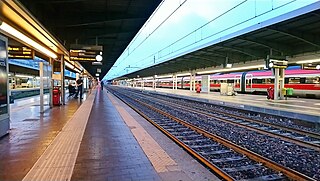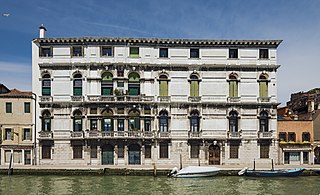
Cannaregio is the northernmost of the six historic sestieri of Venice. It is the second largest sestiere by land area and the largest by population, with 13,169 people as of 2007.

The Grand Canal is the largest channel in Venice, Italy, forming one of the major water-traffic corridors in the city.

Mazzorbo is one of various islands in the northern part of the Lagoon of Venice. Like the other islands in this part of the lagoon, it was the site of one of the earliest settlements in the lagoon which predated the development of Venice. However, these islands then declined and were eventually abandoned. In the 1980s the architect Giancarlo De Carlo built a brightly coloured residential neighbourhood to help to repopulate Mazzorbo. In 2019 its population was 256. It is linked to Burano by a wooden bridge. It was once an important trading centre but is now known for its vineyards and orchards. Its main attraction is the fourteenth century church of Santa Caterina.

The Ponte dell'Accademia is one of only four bridges to span the Grand Canal in Venice, Italy. It crosses near the southern end of the canal, and is named for the Accademia di Belle Arti di Venezia, which from 1807 to 2004 was housed in the Scuola della Carità together with the Gallerie dell'Accademia, which is still there. The bridge links the sestieri of Dorsoduro and San Marco.

Comacchio is a town and comune of Emilia Romagna, Italy, in the province of Ferrara, 48 kilometres (30 mi) from the provincial capital Ferrara. It was founded about two thousand years ago; across its history it was first governed by the Exarchate of Ravenna, then by the Duchy of Ferrara, and eventually returned to be part of the territories of the Papal States. For its landscape and its history, it is considered one of the major centres of the Po delta.

The Ponte degli Scalzi, is one of only four bridges in Venice to span the Grand Canal.

Mestre is a borough of the comune of Venice on the mainland opposite the historical island city in the region of Veneto, Italy.

Venezia Santa Lucia is the central station of Venice in the north-east of Italy. It is a terminus and located at the northern edge of Venice's historic city . The station is one of Venice's two most important railway stations; the other one is Venezia Mestre, a mainline junction station on Venice's mainland district of Mestre. Both Santa-Lucia and Mestre stations are managed by Grandi Stazioni and they are connected to each other by Ponte della Libertà.

The Ponte della Costituzione is the fourth bridge over the Grand Canal in Venice, Italy. It was designed by Santiago Calatrava, and was moved into place in 2007, amid protest by politicians and the general public. The bridge was installed in 2008 and opened to the public on the night of September 11, 2008. The bridge was known as Quarto Ponte sul Canal Grande before the official name was adopted to celebrate the 60th anniversary of the Italian constitution in 2008. Tourists and locals in Venice now refer to it as the Calatrava Bridge.

The Venice Marathon is a marathon road race that has been held each year in Venice since 1986, usually in October. The course starts in Stra and passes through Mestre, Parco San Giuliano, and Ponte della Libertà before ending at Riva dei Sette Martiri in Venice. The marathon is categorized as a Bronze Label Road Race by World Athletics.

The Church of St Job is a 15th-century Roman Catholic church located overlooking the campo of the same name, known as Sant'Agiopo in Venetian dialect, on the south bank of the Cannaregio canal near Ponte dei Tre Archi in the sestiere of Cannaregio of Venice, northern Italy,

Venezia Mestre railway station is a junction station in the comune of Venice, Italy. It is located within the mainland frazione of Mestre, and is classified by its owner, Rete Ferroviaria Italiana, as a gold category station.

Venezia Porto Marghera railway station is a stop located in the trunk railway between Venezia Mestre and Venezia Santa Lucia just before the bridge across the lagoon. It is located at 260.191 kilometer of the Milan-Venice railway and operated by Rete Ferroviaria Italiana. The train services are operated by Trenitalia and Sistemi Territoriali. The technology park "Vega" is in its immediate vicinity.

The Ponte dei Tre Archi is one of the main bridges of Venice, Italy, along with the Ponte delle Guglie, the other bridge spanning the Cannaregio Canal, and the four bridges spanning the Canal Grande: Rialto, Scalzi, Accademia, and the Costituzione. It is located in Cannaregio district (sestiere), just South of Rio San Giobbe, linking the fondamenta San Giobbe, and the South-West area of Cannaregio, to the fondamenta di Sacca San Girolamo and the North-East of Cannaregio. As all other Venetian bridges, the Ponte dei Tre Archi is a pedestrian walkway.

The Riva degli Schiavoni is a monumental waterfront in Venice. It is located in the sestiere of Castello and extends along the San Marco basin in the stretch from the Ponte della Paglia bridge, close to the Doge's Palace to the rio di Ca' di Dio.

The Ponte del Paradiso is a bridge located in Venice, Italy. Crossing the Rio del Mondo Novo, the bridge is almost entirely constructed out of Istrian stone bricks while the steps are paved with Trachyte. It is located within Castello, the largest of the Venetian sestieres. The bridge is known for the unique arch on its southern side serving as an entrance to the Calle del Paradiso, an alley famous for its wooden overhanging eaves.

View of the Cannaregio Canal is a small oil-on-canvas painting executed ca. 1770 by the Italian painter Francesco Guardi. It measuring 48.9 × 77.5 cm. It is now in the reading room of the Frick Art Reference Library alongside the Regatta in Venice. Both paintings were gifted to the Frick Collection by Helen Clay Frick after her father's death. In the painting, Guardi captures a typical scene of Venetian life on the canals. In this particular veduta, Guardi depicts a section of the northern bank of the Cannaregio Canal, one of Venice’s largest canals, located in the Cannaregio sestiere (district) of the city.

Palazzo Surian Bellotto is a Baroque palace in Venice, Italy. The palazzo is located in the Cannaregio district and overlooks the Cannaregio Canal.



















